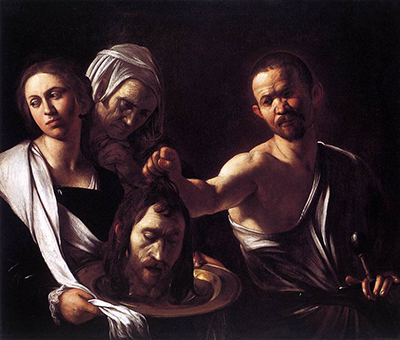Caravaggio's Salome with the Head of John the Baptist (1607), depicts a scene from the Bible, in which an executioner presents the decapitated head of John the Baptist to Salome, whilst an elderly woman looks on.
This scene is taken from a story in the New Testament (Mark 6), in which Salome wins the favour of King Herod of Judea with her dancing.
As a sign of his admiration, Herod grants Salome one request – Salome's mother, and Herod's wife, Herodia, convinces Salome to ask for the head of John the Baptist. Herodia desires revenge against John, since he had reproved Herod for divorcing his former wife in favour of her.
This work dates from Caravaggio's later years, and focuses on realistically depicting the psychological impact of the event, rather than taking a purely narrative approach.
During this period of Caravaggio's life, the painter had fled from Rome to Naples, after being sentenced to death for his involvement in a deadly brawl, and now, in 1607, removed from Naples to Malta, and shortly after relocated to Sicily. He died in 1610, at only 38 years old.
Despite Caravaggio's work falling out of favour in the years after his death, his contribution to western art was later revered by the art historian André Berne-Joffroy, who declared that 'What begins in the work of Caravaggio is, quite simply, modern painting."'
Style
In this painting, Caravaggio's characteristic use of chiaroscuro can be plainly seen. This technique, which literally translates as 'light-dark', uses strong contrasts between bright and shadowy areas in a painting to recreate three dimensional depth.
Caravaggio was among the artists to pioneer the use of this technique to dramatic effect during the Renaissance. Chiaroscuro was also highly influential in the subsequent Italian Baroque style.
Here, the stark contrast between light and shadows throws each figure's features into stark relief, facilitating the artist's exploration of their emotional responses. Both the executioner and Salome herself wear expressions of detachment, giving the scene an eerie quality – devoid of the melodrama which other Renaissance depictions of Biblical stories sometimes show.
Caravaggio transforms Salome from an inaccessible, mythologised figure, into a flawed human woman, in this snapshot of her psyche.
Related Works
Caravaggio uses a similar formula in his Biblical work of the same year, The Flagellation of Christ. The painting similarly combines a muted palette and chiaroscuro to capture a bright, yet human, Christ against a shadowy background.
Biblical and Classical themes were prolific in Renaissance and Baroque painting, and other artists have also depicted John the Baptist's tragic end. Guido Reni's Salome with the Head of John the Baptist (1639) was painted almost a century later, and although the style is clearly Baroque, some similarities to Caravaggio's work can be seen.
The palette used is richer, the figures are similarly set against a shadowy background, highlighting their features. Unlike in Caravaggio's depiction, Salome looks directly at the decapitated head, and her expression is unsettlingly satisfied.
Bernardo Luini also depicted this iconic Biblical scene – earlier than even Caravaggio, around the 1520s. Again, chiaroscuro highlights Salome, who averts her eyes from the head and wears an expression of distress. This work is somewhat more gory than Caravaggio's depiction – the head drips blood, and is held by a disembodied hand which thrusts into frame from Salome's right.
Caravaggio's take on John the Baptist's tragic end diverges from other depictions in the muted, detached expressions he offers to the characters in the scene. Salome's detached reaction is more troubling to the viewer's moral sensibilities than horror or satisfaction – her cold reception implies an amorality which may reflect a society which was beginning to question the validity of traditional Christian moral teachings.




